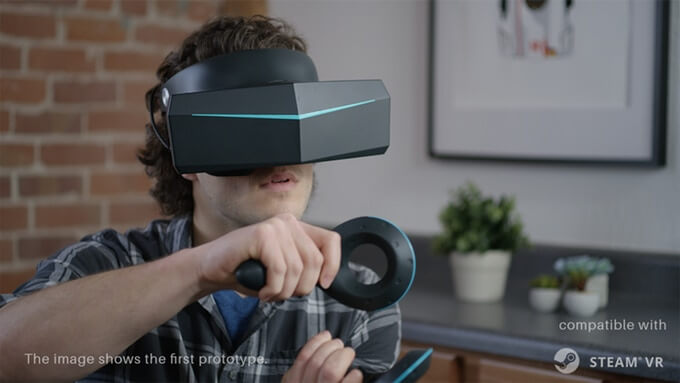If you’re calling yourself a VR enthusiast, you must have heard about Pimax, the headset that has sent ripples through the VR world. SO what is precisely Pimax, and what does it offer? Do we really have a next-generation headset on our hands? Answers to these questions and many more will be given in this rather lengthy post, so keep on reading.
Who are the guys behind Pimax?

Pimax is developed by a team of researchers based in Shanghai, China. The company has already produced a Pimax 4K VR headset and shipped it in excess of 30 000 copies, so that fact alone gives the company some credibility and faith in its ability to deliver what has been promised and showcased.
The company has recently decided to step up its game and deliver a product that would wrestle the title from Oculus and Vive as the most powerful VR headset on the market, or so they claim.
Display

There are two versions of the product: 8K and 5K, the Pimax 5K alone ups the ante with 2,560 x 1,440 pixels per eye, 90 Hz refresh rate and a 200-degree field of view, while Pimax 8K takes it even further with an impressive resolution of 3,840 x 2,160 per eye with the same FOV. Just for comparison, both Vive and Oculus have 1,080 x 1,200 pixels per eye, with a 110-degree field of view and a refresh rate of 90 Hz.
As we can see from the get-go, Pimax is simply dominating the other two, with significantly higher resolution, pixel density, not to mention increased FOV which has collected widespread applause (but more on that later).
Its Kickstarter Campaign has sent shockwaves across the VR community, and rightly so, as the product specifications put it in the top tier of headsets in existence.
The campaign itself was small in scope, only $200,000. It’s a small amount to ask for a product this demanding on the manufacturer’s side. The main purpose of the campaign was probably visibility. They most certainly succeeded in that task. The campaign has drawn in almost 6,000 backers with over $4.2 million USD collected. The scope of the campaign, as well as the amount raised, points to the demand for a strong VR headset that would raise the bar for high-end VR headsets available on the market.
Pimax 8K headset prototypes have already been demonstrated on major exhibitions and conventions. The team’s burning desire was for quite some time to deliver a better headset to VR enthusiasts around the world. The passion they have is clear from all the given interviews. Their sincerity is evident by the amount of care they put in answering all the questions backers may have on their reddit page as well as in official forum.
However, there are still many questions left unanswered. Pimax 8K headset, if proven stable, will truly be a challenge to surpass. On the flipside, the company was rather unknown before launching the Kickstarter campaign. For this reason alone, many doubt their ability to actually manufacture a fully functional product and deliver on their promises.
Worlds first 8K VR headset you say? Oh..really?
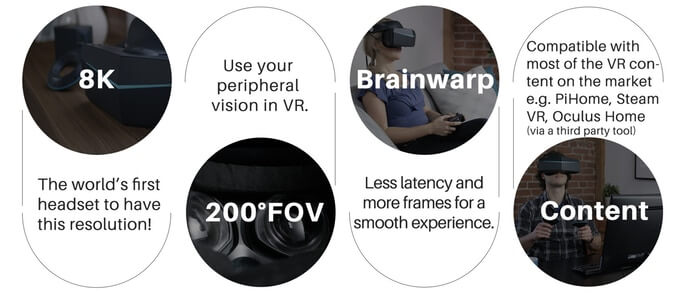
Now, the first thing that will catch your eye is the sensational headline of 8K resolution display, but that claim would be…inaccurate, to say the least. Now, we will ascribe that statement to their over-zealousness and let it slide…for now.
Hopefully, the manufacturers will come to a realization that such marketing statements will only provide a target for critics, and will ultimately lead to a self-sabotage. An 8K monitor typically displays 7680×4320 pixels. The combined display resolution of Pimax 8K is 2*3840×2160, or 7680×2160. This is a full 8K display horizontally, but only half the pixels vertically, so per eye, you get a 2K*4K display, or combined 8K*2K.
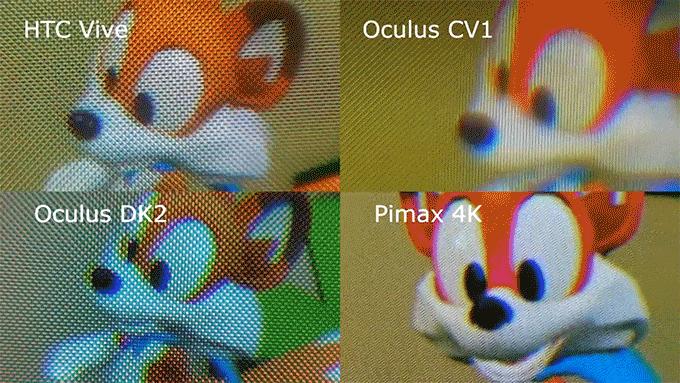
The input of Pimax 8K is 5K upscaled to 8K, meaning, that it takes the input from graphics card of 2*2560×1440 and then it upscales the image to 4K*2K, so the original input is much lower than the final display. This means that, while the display is 4K*2K, the original input is actually not 4K per eye, but much less.
The reason behind that is obvious: rendering such a big image would require an enormous computational power. Additionally, transferring the original 4K*2K image from the graphics card to the headset requires a very capable cable. This means that the original resolution is not 8K, so you’re rendering a stretched image. The reason why behind that decision is an obvious one, the task of rendering such an image would require massive workload on GPU. And let’s not even begin talking about how even the most high-end commercial graphics cards would handle prolonged abuse like that.
There is Pimax 8K X in development, which will accept display’s native resolution of 7680×2160 and display it with no scaling. However, it is still a work in progress that would require a next-generation graphics card, at least an NVIDIA GTX 1080 Ti(probably even Nvidia Volta).
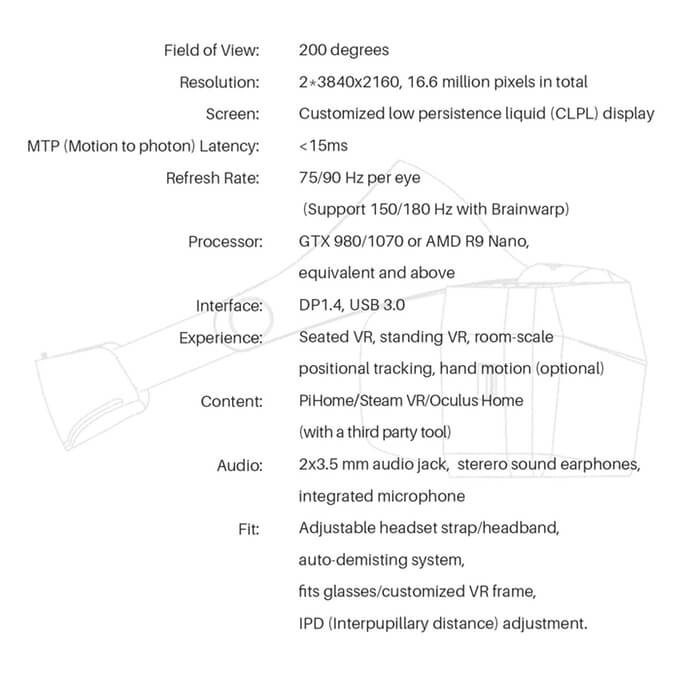
Since the load on cables is so great, the manufacturer has opted in for using DisplayPort 1.4 connectors for their Pimax 8K and Pimax 8K X headsets, and will provide adapters so you can use HDMI port.
There is a shroud of mystery surrounding the Pimax 8K X at the moment, with many unresolved questions. There’s no info whether the users will be able to choose the input resolution (in case they do not possess such a strong graphics card), as well as its release date.
Hopefully, if everything goes according to their schedule released on Kickstarter campaign, it will be shipped in the second quarter of 2018. It is unclear whether it will even be commercially viable, since it hasn’t been completely tested yet, and the market for such a powerful headset might be lacking in the nearest future.
Furthermore, in the world of Pimax itself, they say: “Based on our comparison test, there is no obvious difference in terms of gaming experience between 8K and X, but X demands much more powerful GPU”.
BrainWarp – what is that?
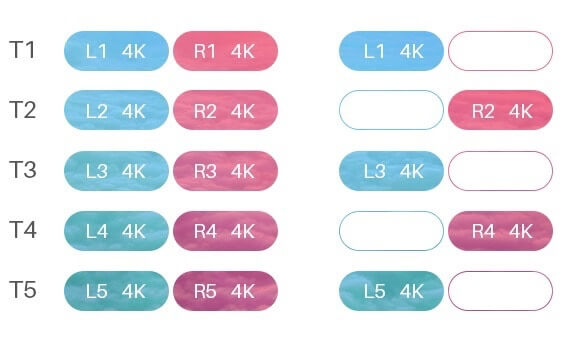
For a better VR experience, as well as for the purpose of reducing hardware requirements to run Pimax 8K headset, they developed a set of technologies called Brainwarp. Brainwarp is similar to asynchronous reprojection, meaning it is used for rendering and displaying image in a sequence.
It is accomplished through fast switching between left and right eye, rendering (150/180 times per second) so fast that the eye can’t perceive it, but significant in that it is possible to run it with a graphics card such as GTX980/1070. The benefits are immense: boosted refresh rate, reduced latency and decreased GPU pressure, all resulting in a smoother VR experience.
Have the motion sickness and screen door effect been eliminated?
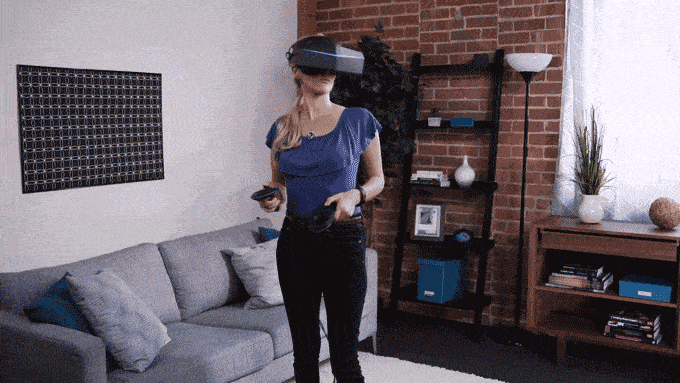
The thing that has been bothering a great many VR players across the world, ever since Oculus first came into being, was screen door effect. The SDE has become a scourge since then, plaguing every VR headset since, but has its reign come to an end?
People behind the Pimax 5K and 8K headset claim so, and many people who have tried it support that claim. It has not disappeared completely, but compared to the Vive, the differences are drastic. It is still visible if you were to look for it, but it is not nearly as noticeable as with Oculus or Vive, where you’re constantly aware of it in the back of your mind. Since the pixel density is so dramatically improved over its two counterparts (if they can be regarded as such in the area of pure resolution), SDE can be considered to be reduced to a minimal, almost unnoticeable levels.
One other significant downfall of using VR headsets for prolonged periods of time is that feeling of nausea. It can take from a couple of minutes to half an hour to develop, depending on how accustomed you are to the headset. Pimax claims they have eliminated motion sickness, but none agree to that claim.
According to guys at Linus Tech Tips, motion sickness developed after only a couple of minutes, but he gives an educated claim as to why. You see, the whole purpose of a VR headset is to fool the brain into believing that the images projected into display are actually that of real space surrounding us, but since the current headsets are limited by today’s technology they cannot fool our brain completely.
So, even though we can perceive the image as stereoscopic and even believe that we are in fact standing in space, since the images cannot respond to our inputs in real time, as is the case in real life, our brain feels something is not quite right…the result of which is the motion sickness, a nauseating feeling after prolonged play. Not to mention that increased Field of Vision of 200-degrees significantly increases its effects.
Most of the motion sickness, according to guys at Linus, comes from slightly distorted display, which does not respond as fast to the head movements, especially when moving the head up and down. But, Pimax made a statement that the product sent to customers will feature new and improved lenses, so we can hope that motion sickness will not be such a big issue.
That’s all sweet and dandy, so what are the benefits of having a Pimax 8k headset?
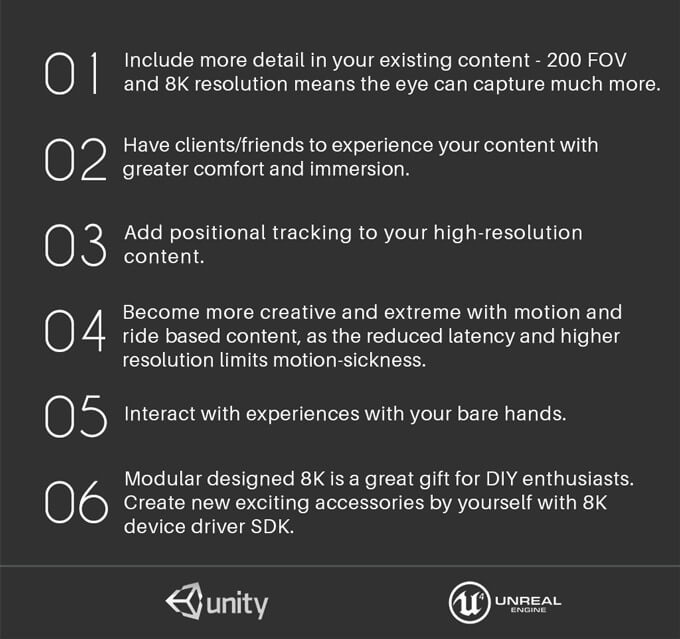
One thing all those who have been graced with the opportunity to put the magnificent Pimax 8K headset upon their heads agree is that amazing Field of Vision. The human eye has a natural 220-degree of vision, so when using Oculus and Vive, which both have 110-degree, you see black edges around the screen and you have an effect of looking through the scuba mask. No more.
Pimax has truly stepped up its game by producing headset with an incredible 200-degree FOV, making it almost identical to the one we naturally have, and thus almost completely eliminating black edges at the border of the screen.
Now, you can use your peripheral vision as is naturally intended, which has an effect of a greater feeling of immersion, unlike any other. That is the one thing everyone agrees about. The increased FOV is simply great and is a step in the right direction. The FOV per eye is 140 degrees with a binocular overlap of 80 degrees, quite good compared to our natural 120-degree overlap.
One very important thing to point out would be the fact that Pimax’s screens are angled towards each other, and SteamVR currently does not support that. That might be the cause for the visible distortion some reviewers have complained about, and could easily be completely eliminated in future.
Thanks to significantly increased FOV and high-resolution, Pimax 8K also produces incredibly sharp images and crisp, readable text, last of which was a special pain for many.
What is the display and lens quality?
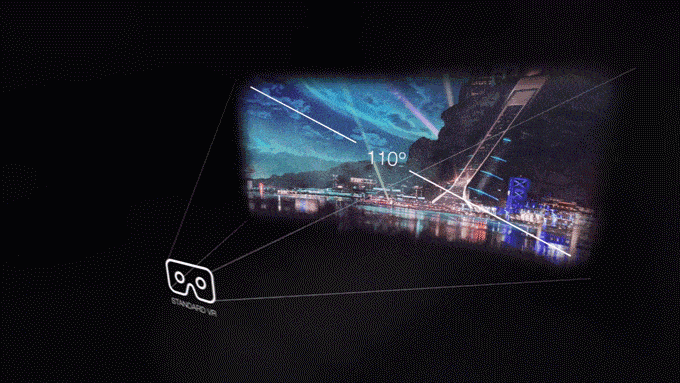
Contrary to what you may expect, the displays are not OLED, but LCD, a special version of LCD display called customized low persistence liquid, or CLPL for short, which they produced together with a partner. While they claim that its performance is on par with OLED, that is simply not the case. OLED is much better in areas of contrast and brightness and in response time which is almost instant, while the LCD, at best, lags a couple of milliseconds.
The OLED display has the most visible advantage over LCD in games with a dark background, but in those with brightly colored backgrounds, the differences are unnoticeable. Nevertheless, LCD monitors have been in the industry for years. Although they don’t offer the same brightness and contrast, it is good enough, so much that it shouldn’t be an issue.
Unlike some headsets on the market, which have one display split in half for right and left eye, Pimax has two distinct 4K displays. Some people pointed out the possibility of the overlapping of lenses as a potential issue, but many reviews reported no such thing as blurring and no distortion at all.
Also, lenses have far fewer god rays than the Rift, meaning the color does not have that glaring attribute which makes each object stand out much more distinctively to the viewer, so we see an improvement in that area. Also, some of the reviewers reported distortion of the lenses at the edges, but only slightly. When you’re particularly looking for it, you will notice it, but even that might not be an issue since Pimax has reported that the lenses used in the final product will be even more improved.
One thing reviewers did point out is the fact that, although the Kickstarter campaign clearly advertises that Pimax can run smoothly at 90 Hz, and it theoretically can, games were not run on that refresh rate, but one closer to 80Hz. Stability is an issue and will require more testing on their part to provide a stable 90Hz display.
As they said in the post:
„The display panel supports 90Hz according to its specification, and it has proven a stable 90Hz in another project. The display port is DP1.4 and the chip we used supports DP1.4 as well. So theoretically, Pimax 8K can support 90Hz.
But the stability is much important because our HMD should work out of the lab in thousands of computers condition. In the past two weeks, we have done more stress tests from 75Hz to 85Hz base on V3 hardware (latest DP 1.4 solution). Up to now, the 80Hz is confirmed stable. 82Hz just pass the initial test standard. And now we’re trying to optimize on 85Hz and 87Hz. Since 90Hz is the upper limit of the whole system”
One of the most important factors, which influences the level of immersion would be Motion Response Time, or plainly the time it takes for an image to change according to the player movements. Lower Motion Response Time equals better immersion, as well as lower effects of Motion Sickness.
The whole equation for Motion Response Time goes like this:
MTP = sensor response time + GPU rendering time + 1/refresh rate + display switching time
Many agreed that MTR could be improved, and as we can see refresh rate is one of the factors, so by providing a stable 90Hz display MTR would be significantly lowered.
How about the tracking solutions?
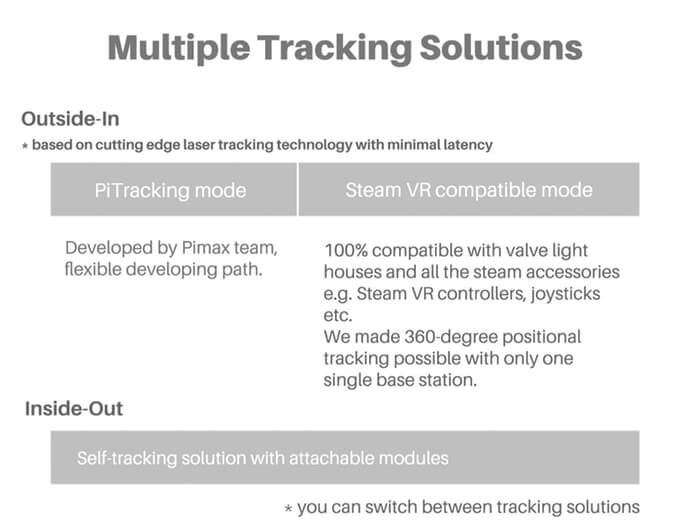
The headset was designed to support both outside-in tracking as well as inside-out tracking solution with a module to support it. It is compatible with all Valve accessories and it will be sold as a SteamVR Tracking 2.0 device. That means it has the new Triad Semiconductor sensors which will work with Lighthouse stations v1 and v2. The outside-in tracking is based on cutting-edge laser technology which provides minimal latency. You can switch between PiTracking mode and Steam Compatible mode.
In addition, Pimax has promised a house-scale (>50 sqm) tracking which will be enabled with a new module. In addition, the company claims that headset will work with only one base station!
What about the other Pimax 8K accessories?

Pimax 8K is designed as a modular headset, so you can add custom built-in lenses, with the possibility of adding many compatible accessories. These are open for development by third party vendors, and the company itself has many planned (some of which are already in production) such as:
- cooling fan
- hand motion module
- scent enabling
- customized VR frame
- headband with earphones
- eye tracking module
- extendable interface
- wireless transmission (so they claim)
- inside-out tracking
- …
There is no doubt that Pimax is aiming for greatness, and adding only some of these features will greatly improve your VR experience. Some of these modules are already existent, such as integrated audio and hands tracking.
Scent enabling is developed by a third party vendor, same as eye tracking. Eye tracking module would, if done as intended, use an infrared laser to follow pupils. This would be achieved while using a headset, so that the image at the center of the vision would be rendered clear, while the periphery of your vision would be blurred, as is the case in natural sight. That is one of the examples when blurring might come in handy, for a change. Inside-out tracking would make the headset usable without the Lighthouse stations, but it is probably a work in progress.
Wireless transmission might only be their wish, as there is no possibility they could be rendering 4K transmission wirelessly. So, if it will ever see the light of day remains to be seen.
Hand tracking has been made in partnership with Leap Motion and, according to users, works great. By the looks of the reports, the tracking is stable and the range is wide.
The decision to make Pimax a modular headset is a great one, who knows how many accessories will be developed and thus greatly increase the value of Pimax ecosystem!
Controller
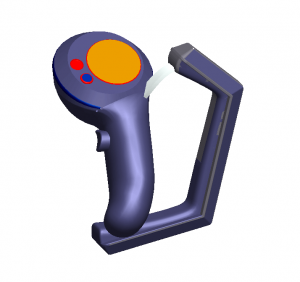

Undoubtedly, the quality of a controller is an issue of great importance, there is nothing more irritating than a clumsy controller to break your immersion while playing your favorite game. Pimax comes with controllers which look like exact copies of Vive controllers, albeit with significantly lower quality.
It seems that most of the money was used in an effort to produce the best headset possible. During the time of their Kickstarter campaign, Pimax has released images of their new controllers, which were made similar to Valve’s new Knuckles controllers, so hopefully, their tracking capabilities, as well as overall ease of use, will be on par.
Headset build and comfort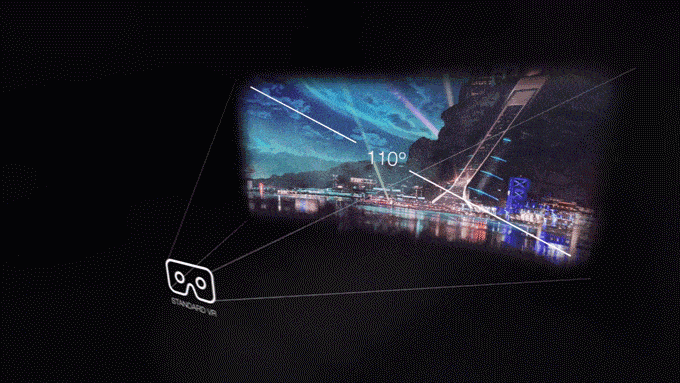
When you look at the photos of Pimax 8K headset, one of the things that cross your mind is what kind of feeling would it be to wear it. The people behind Pimax have taken that into consideration, so they designed a headset which is lauded by everyone as super comfortable, with a great distribution of weight, making it very light to wear.
For all those who wear glasses, you can keep them on while wearing the headset. Furthermore, you will be able to order prescription lenses on the Pimax website, and to attach magnetic lenses adapter inside the Pimax headset, which will allow you a greater level of comfort.
The padding of the headset is soft and replaceable and the straps will be similar to the Vive’s Deluxe Audio Strap. All of these combined provide a headset with a level of comfort equal to that of a Vive headset, if not greater.
Interpupillary distance adjustment
IPD adjustment will be possible in the final product, but the current prototype did not implement it, so we can only judge its implementation after the headset has been shipped.
Will I be able to play the existing games on Pimax 8K since it uses greater FOV?

The question that has got many VR enthusiast worried is, due to Pimax featuring 200-degree FOV, will the developers need to update the existing games for them to be playable on Pimax headset?
Some games have their standard parameters hardcoded, so they cannot support the 200-degree FOV and result in a warped image, since the Pimax stretches the image further from the center to provide an increased FOV. It has to be taken into account that current SteamVR games are made for 110-degrees FOV, but players need not be alarmed just yet.
Although the SteamVR runtime takes the game output and converts it to a 110-degree FOV, the games themselves are not locked into 110 degrees FOV (except a few). Therefore, it quite possible there won’t be any warping of the images present. There is a possibility SteamVR will have to make a few updates to its runtime.


The guys at Pimax have sent a screenshot that proves that the 200-degree image truly shows more of the environment, but the warping effect might still be present since the games were not designed with a 200 FOV in mind. There is no doubt that in the near future, that won’t be an issue at all, since the game developers will take the new platform into account.
However, to avoid any unwanted backlashes from the hardcore fans of published games, Pimax has announced that they have taken into consideration an option to let the players choose the rendering FOV, leaving no place for any warping and distortion.
What is the biggest difference between Pimax 8K and Pimax 5K?
In a nutshell, resolution. Pimax 5K is a lite version of Pimax 8K and provides 2*2586×1440 the results of which are 7.4 million pixels compared to that of 16.6 million pixels of Pimax 8K. Pimax 5K has the same 200 FOV, the same modular design and is the same in all regards except in resolution and price.
One question remains unanswered still, though. In their Kickstarter campaign, they have said that Pimax 5K will be shipped with OLED displays, but have since given up on that option and decided to go with the same CLPL (Customized Low Persistence Fluid) monitors which are used in Pimax 8K, so at this point it is not known whether the original backers of Pimax 5K will receive OLED or CLDC displays.
The latest information is that they will be given an option to choose which display will be used, so hopefully, that will be the case, since some of the backers decided precisely for that version of the headset because of its OLED display.
If you’re having doubts whether to buy Pimax 8K or 5K, that decision will have to be made at the time the product becomes viable for commercial use. However, if the only difference ends up being resolution, then the only decision would be whether or not you will be ready to cough up a few extra shekels for better resolution. My reasoning is, if you’re opting for a headset with the best resolution available, why not go all the way?
So…what kind of PC do I have to have to use Pimax 8K headset?
You have decided to buy it, you want to use it… but wait, can you even run it? The mere fact that the resolution is much bigger than the current-gen headsets is an indicator just how monstrous the PC gaming rig requirements will be to even approach the Pimax 8K. But, don’t get scared just yet. Thanks to their BrainWave technology, as well as the fact that Pimax is actually using upscaled 5K input, the minimum requirements for running a Pimax 8K headset are quite reasonable:
- GPU: GTX980/1070
- CPU: i5
- RAM: 8GB
Pimax 8K X is another story. The mythical creature it is, it has not shown its face in the light of day, but at the very minimum, the requirements are:
- GPU: GTX1080 Ti (still being tested for stability, probably closer to the truth would be 1080Ti SLI or even Nvidia Volta)
- CPU: i7
- RAM: 16GB
As most of you are well aware, VR gaming is a privilege reserved for those fortunate ones who are able to equip themselves with gaming rigs fit with latest advancements in technology. It seems that the Pimax 8K has put a reasonable demand on the user, while Pimax 8K X will prove to be a force to be reckoned with even for the best gaming rigs out there.
Well, I admit, you got me hooked. Where and when can I buy that Pimax 8K you keep talking about?
Whoa, whoa… hold there partner. I know, I know, I’m the marketer Pimax team wish they had in their ranks, but don’t go waving that money in front of me yet!
You see, cowboy, the pre-order Kickstarter campaign is finished, so if you want to put your hands on that Pimax bad boy, you will have to stand in line like everybody else. When and where, it is still unclear, since the Pimax team wants to play fair, first they will fulfill their obligations to all the campaign backers, and only after that is taken care of, the commercial product will be put on the shelves.
The commercial version Pimax 8K headset will be, according to their words, „better packaged and crafted, and the price would be different“. Surely they will make a few adjustments based on the feedback from their backers, but the differences in the final product will probably not be that big. Also, the build of the headset will hopefully be more on the quality side, since the cheap plastic doesn’t feel all that great.
So, how much does the Kickstarter version of Pimax 8K cost?
Pimax 8K, on their official campaign, sold for $499, while 8K X was $699, and the lite version 5K was going for 399$. For an extra $300 backers were offered the full package bundle, which included Lighthouse stations and controllers. That might not seem like a bargain, but considering a significant bump in quality and performance, it is a reasonable price to pay.
The features that got people off their knickers are incredible resolution, together with amazing FOV, the results of which are increased immersion into the world of VR. Compared to Pimax 8K, Oculus and Vive really look outdated.
Do we truly have a second generation VR headset on our hands?
That remains to be seen. There is no doubt that Pimax has upped the ante in the world of VR, the bar has been raised, the glove has been thrown, the challenge has been issued. A slap has been delivered across the face of both Oculus and Vive, so it remains to be seen what kind of surprise Vive 2 has in store for us.
The guys at HTC will have to tackle the increased FOV and resolution, which make Pimax 8K stand out so drastically, or they will risk being in the shadows of a new giant in town. That guy Pimax is going places they say. Better throw a worthy fight, or step out of the way.
All in all, Pimax has produced a headset that has taken the current technology to its limits, all in an effort to produce a more immersive VR experience. Pimax 8K is not perfect, there is still ground to cover, but the guys there want to make a name for themselves and to truly build a brand worthy of the legacy.
Hopefully, Pimax will become a new platform filled with new modules and brimming with games which will truly utilize its capabilities!
